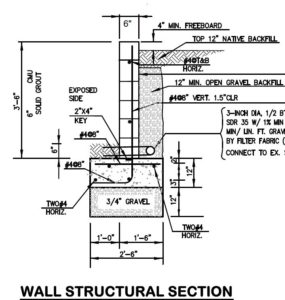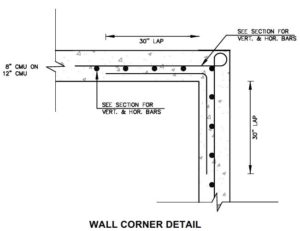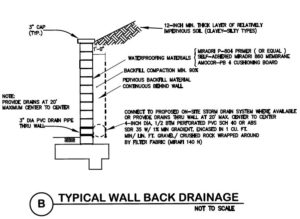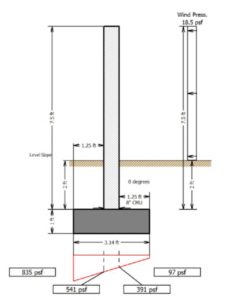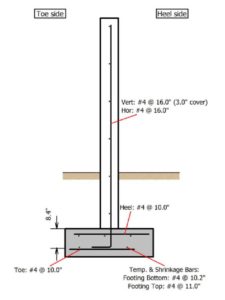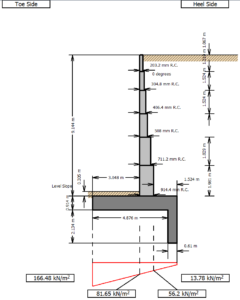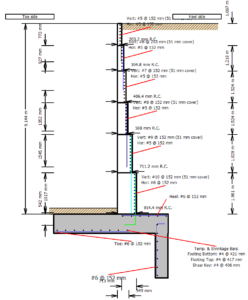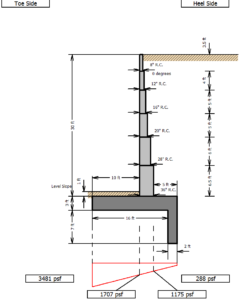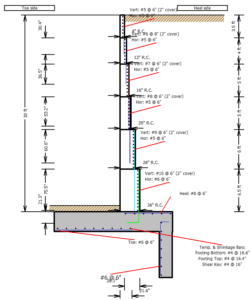RAPID RETAIN – GEOTECHNICAL & STRUCTURAL EFFECTS ON CANTILEVER/RESTRAINED RETAINING WALLS – V4. (2018 IBC/ACI 318-19) – Accurate & Saves you time.
SoilStructure RAPID RETAIN, version 4 is a tool for designing Abutment Wall, Wing Wall, Cantilever Retaining Wall & Basement Wall. It is time consuming to do all the stability and reinforcement design using in house tools. The program can also analyze Fence Property Line Walls. Rapid Retain has plenty of Rebar from several Countries. We have no maintenance fee. The software supports both the SI Units & the English Units.
Updated November 20, 2024
$295.00 – $600.00
This product has multiple variants. The options may be chosen on the product pageCompatible with Windows XP/Vista/7/8/10/11
Return on Investment (ROI) calculator
When you have a retaining wall to design, you have a collection of checks to satisfy. Some of these checks are stability analysis like sliding and overturning. Other checks are per ACI 318 like minimum reinforcement, shear and moment capacity. However, a multitude of geotechnical checks are also needed. These include settlement, wall deflection and stability of a temporary vertical cut.
SoilStructure RAPID RETAIN Software considers the soil effects and the temporary excavation stability of retaining structures. ( VIEW Retaining Wall Video )
This program is a retaining wall design software that combines geotechnical checks and structural design calculations as one complete treatment of stem wall design.
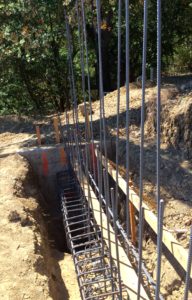 SoilStructure RAPID RETAIN software has the following unique capabilities:
SoilStructure RAPID RETAIN software has the following unique capabilities:
- Taking into account the response of bearing pressure when axial dead & live loads are present
- Computation of retaining wall footing settlement due to distortion & consolidation settlement
- Checking for stability of excavation cut
- Sizing stem walls for Wind
- Design of shear stem key @ the top of footing – bottom of stem interface
- Calculation to check of whether Active or At rest or in between earth pressures apply to the stem
- Calculating passive earth resistance when passive soils are descending, ascending or level
- Calculating at rest earth pressure when the backfill soils are overconsolidated and inclined
- Option to include all 3 common surcharges – point load, line load and strip load
- Creating P-M interaction diagram for each stem wall section
- T & S Bars analysis and detailing diagrams
- Development, splice length & detailing is automated for the stems, heel, toe and keyway
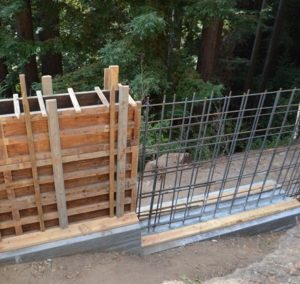 In addition, the following design checks for a cantilever & restrained retaining wallS are in RAPID RETAIN:
In addition, the following design checks for a cantilever & restrained retaining wallS are in RAPID RETAIN:
- Reinforcement for Base Shear Keyway
- Shear & Moment Design for up to 6 Concrete Stem or CMU stem sections
- Applied forces and moments at many locations along the stem
- Shear & Moment Design for Heel Slab
- Shear & Moment Design for Toe Slab
- Design of optional footing keyway as a bracket
- Temperature & Shrinkage for Stem and Footing
- Inclusion of detailed Tables, Charts, References and Dynamic Diagrams
- A compact, detailed and color report with reinforcement cross section that is drawn to scale
- A 7 to 12 page report (depending on surcharges and stem sections) can be printed in PDF or on ink.
-
You can analyze Two Layer Backfill Soils
-
You can also analyze using Vector Analysis (LADBS) Method
SoilStructure RAPID RETAIN V4 references many recent and few obscure but great publications. Option is given to use friction angle & soil unit weight with Rankine, Coulomb or Muller-Breslau or the equivalent fluid pressure. We encourage the use of friction angle/unit weight option as these are fundamental properties that are measurable in the geotechnical lab. Three parallel windows are displayed to reveal the effects of your input and output. Users are assumed to be skilled in the “manual design” of retaining walls.
Basement wall design philosophy: We fix the stem at the footing base and pin it at the top for the stem wall. The program will give you the lateral force at the top of the wall. We also suggest you check a cantilever condition of all restrained walls, since the wall may be backfilled early by the contractor. The double curtains of steel will come in handy for restrained walls with ten inch stem width or greater.
A word about the Equivalent Earth Pressure (EFP) method to design cantilever & restrained retaining walls. We provide this option because it is in most soils reports. According to Huntington in 1957, this EFP method should be discontinued. That is because it does not represent ascending backfill slope pressures very well.
We see some soils reports saying something to the effect of “If no wall movement is permitted, then design for At Rest earth pressure”. This is a misunderstanding of At Rest earth pressures. At Rest pressures do not apply if “we don’t want” movements. Rather they apply when the top stem is prohibited from forward movement, as in the case of lateral restraint at the the top of the wall.
Question a designer may face is; whether to design a wall as a cantilever stem because it will ba backfilled early or as a restrained stem wall? If the retaining wall is restrained in the long term, then it should be designed for the At Rest earth pressures. If however, there is no top restraint, then the retaining wall should be designed for Active earth Pressures.
Sometimes, you will need to review the retaining wall design of Project Engineers. SoilStructure Retaining Wall Software assigns colors to bar sizes. At a glance, you can see if one or two bar sizes have been utilized for your retaining wall project or if 3 or more bars have been used for reinforcement design, in which case you can optimize the number of bar sizes.
Other times we need to design a property line retaining wall. Often this has approximately 2 ft of backfill on both side and about 6 ft of fence wall. When such situations are encountered, you need to design the upper portion of the stem wall with wind pressure that can come from either direction. Therefore we balance the retaining wall footing dimensions of Heel and Toe.
There are some municipalities that don’t allow subdrain behind a retaining wall. In such a case, SoilStructure Retaining Wall design software allows you to enter the GWT height at the top of the backfill. This will have an effect on stem design, toe & heel bearing pressures, sliding factor of safety and overturning factor of safety.
In most soils, specially at the passive zone, we encounter some cohesion. SoilStructure Retaining Wall gives you option to utilize just friction in the passive zone or combine friction & cohesion as in the case of cohesive soils or in Bedrock materials. We suggest that you limit cohesion in plastic Silt soils. You should use some cohesion in Clayey soils, though.
Below are designs produced with this CANTILEVER RETAINING WALL Design Software (CAD Software was also used).
Our Retaining Wall Software give you option to use Rankine, Coulomb, Muller-Breslau or Equivalent Fluid Pressure. If you choose Rankine method, you are ignoring wall friction, therefore you can use a lower Factor of Safety against Ultimate Passive (1.25 to 1.33 is adequate). If however, you choose Coulomb or Muller-Breslau method, it is suggested that you use a Factor of Safety against Ultimate Passive ranging from 1.5 to 2.0.
Another advantage of SoilStructure Retaining Wall Software is that it gives you stem wall deflection from the base of the stem to the top of the wall. The Retaining Wall Designer can check the top of the stem wall deflection and see if it has moved enough to be in “Active” State or if the wall should be designed for pressures higher than Active but less than At Rest pressures. The program will tell you whether to design for Active pressures or a value greater than Active but less than At Rest earth pressures.
With the retaining wall software output, you will see stem wall deflection due to STATIC earth pressure (Height < 6ft) and stem wall deflections for combined STATIC + SEISMIC earth pressures. Therefore, you don’t have to resort to finite element analysis to determine your overall wall deflection.
We had to make a decision of showing each calculation step with many pages of output or showing enough output but to concentrate on geotechnical checks and structural detailing. We chose the latter. This SoilStructure retaining wall software uses ACI 318-19 provisions and dynamic diagrams to show the bars & detailing including calculation of Temperature & Shrinkage Bars. You get a 7 to 9 pages report output to document your retaining wall calculations.
If you want to design a retaining wall on drilled piers and grade beam, go to this page.
WHAT ARE NEW USERS SAYING:
“I have been doing retaining wall calcs by hand for many years and started looking for a program to speed things up. Yours was the best, most logically organized one I found and it also had the best graphical presentation of the design.” Dean Carlson, P.E., TN, USA.
We are seeing more New users and we think you should join us. We only have about 4 updates the entire year. The retaining wall software is so intuitive that we get only 2 support questions a month (from all the users combined). And when you contact us, we respond within 24 hrs. If you leave us a voicemail, we call you back the same day. And if you open a 6 month old retaining wall file that passed design checks back then, it will still pass the design this month. You get a USB Key that is good until the next Building Code release and you never pay us any annual fees.
Sample Reports
| Sample #1: SoilStructure Cantilever Wall | Sample #2: SoilStructure Basement Wall | |||
| Sample #3: SoilStructure Driveway Short Wall | Sample #4: SoilStructure Fence Wall with Guard Rail |
Screen Shots of RAPID RETAIN
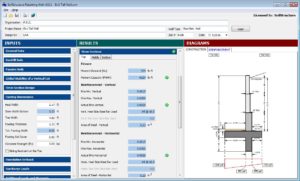 |
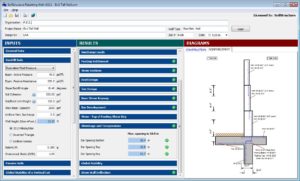 |
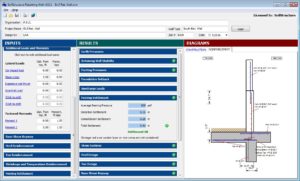 |
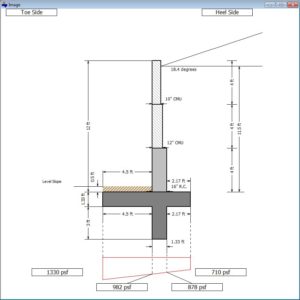 |
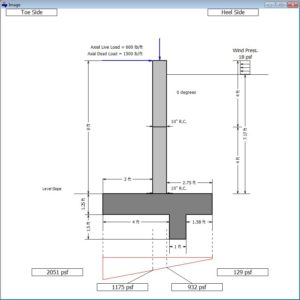 |
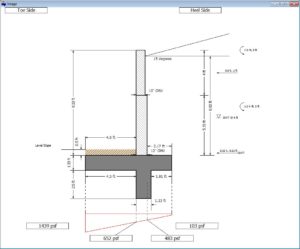 |
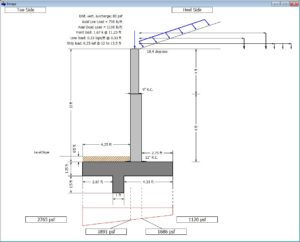 |
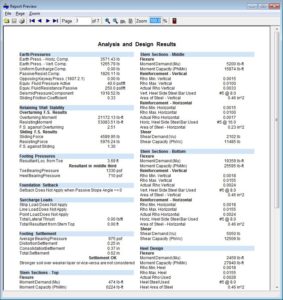 |
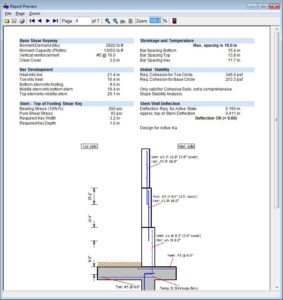 |
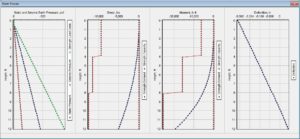 |
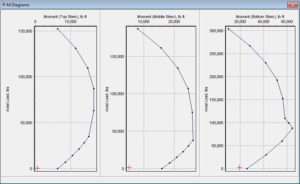 |
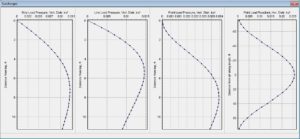 |
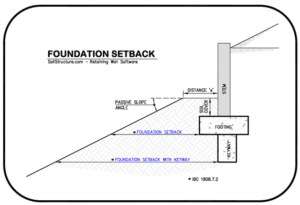 |
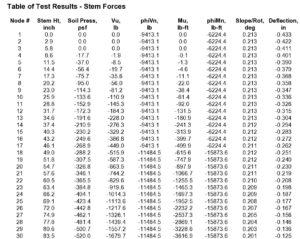 |

